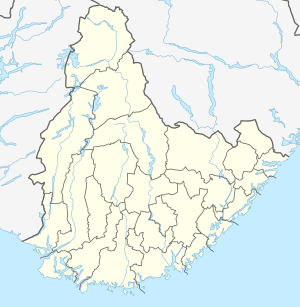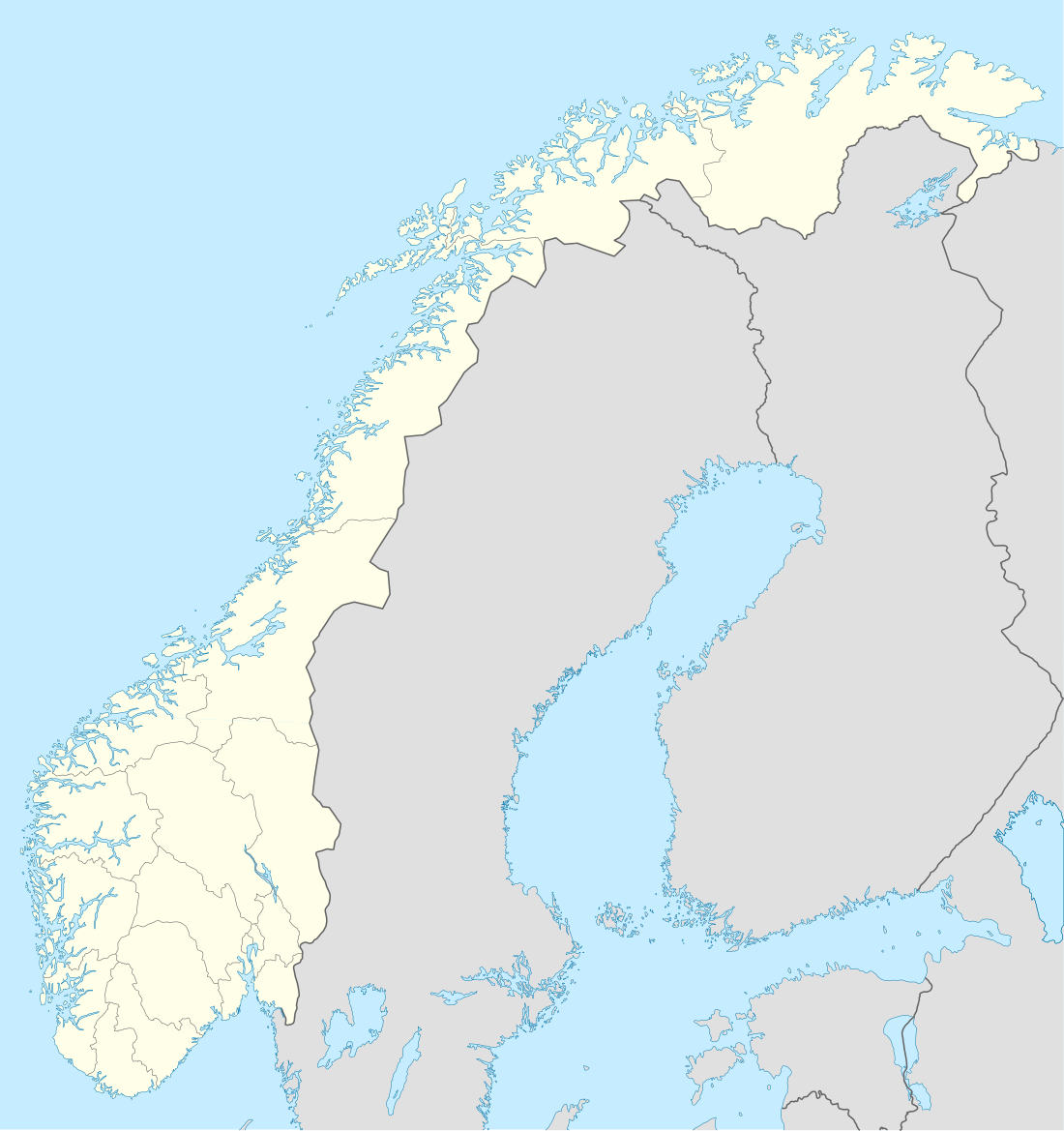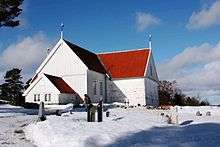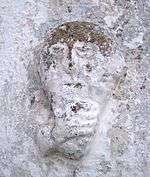Tromøy Church
Tromøy Church (Norwegian: Tromøy kirke) is a parish church in Arendal municipality in Agder county, Norway. It is located in the village of Brekka on the east coast of the island of Tromøy. It is one of the two churches for the Tromøy parish which is part of the Arendal prosti (deanery) in the Diocese of Agder og Telemark. [1][2][3] This was the main church for the municipality of Tromøy from 1878 until its dissolution in 1992.
| Tromøy Church | |
|---|---|
| Tromøy kirke | |
View of the church | |
 Tromøy Church Location in of the church  Tromøy Church Tromøy Church (Norway) | |
| 58°26′59″N 08°51′51″E | |
| Location | Arendal, Agder |
| Country | Norway |
| Denomination | Church of Norway |
| Previous denomination | Catholic Church |
| Churchmanship | Evangelical Lutheran |
| History | |
| Status | Parish church |
| Events | 1748: Complete renovation |
| Architecture | |
| Functional status | Active |
| Architectural type | Cruciform |
| Completed | c. 1100–1150 |
| Specifications | |
| Capacity | 290 |
| Materials | Stone |
| Administration | |
| Parish | Tromøy |
| Deanery | Arendal prosti |
| Diocese | Agder og Telemark |
The white, stone church was built around the year 1150 and over the centuries it was enlarged and expanded. In 1748, the church was converted into a cruciform design by the architect Ole Nielsen Weierholt. The church now seats about 290 people.[1][4] As a medieval building, it automatically has protected cultural heritage status.[5]
Location

The church stands between Hove and Brekka, on the outer shore of the island of Tromøy. Before afforestation took place in the late 1900s, the church was visible from the sea. The church was used as a landmark for navigation in the Skagerrak because it was an easily recognizable element in the outline of the coast seen by sailors. It is marked on all nautical charts, and until 1940 the National Office for Lighthouses and Coastal Safety (Statens fyr- og merkevesen) was responsible for painting the church's south walls white.[6]
History
The first priest known to have served at the church was Sira Ifvar, mentioned in a court document from 1320.[6]
As late as 1794, Tromøy Church was the parish church for Holt, which covered a much larger geographic area than Tromøy itself, and many had a long journey to church that was hazardous in winter. Since 1878, they have been separate parishes; the mainland portion of the parish of Tromøy covered an area from Strømsbu (west of Arendal) to Eydehavn, at that time it also included part of the municipality of Austre Moland as well.[7]
Original construction
Most likely, Tromøy Church originally had a rectangular layout that concluded with an apse facing east. Its walls are 1.5 meters (4.9 ft) thick. Experts that have studied the church believe that the church was first built in the old style and that the structure's style and details suggest that it is one of the oldest existing churches in Norway today. Archaeological excavations are required for more accurate dating. In Old Norwegian the church was called Thrumu kirkja (Thrumu Church).[6] The church was later extended and the choir was expanded to the east. This probably took place in the Middle Ages during the Gothic period, at some point between 1300 and 1400.
It has also been hypothesized that Tromøy Church may have had a round west tower.[4] Many of its reused stones have a slightly curved surface, which may indicate that they were used in the outer surface of a circular construction. It is known, for example, that Lunner Church had such a round tower.[8]

Rebuilding and restoration
The church was entirely rebuilt in 1748. The medieval long church was divided in half and used as the transept for a cruciform church with a nave and choir built of wood. Ole Nilsen Weierholt was in charge of the construction. All of the walls were increased in height, and the ceiling was barrel-vaulted. The church was richly decorated with Rococo ornamentation painted by Jørgen Schultz in the 1750s. This was painted over in the 1880s, but was uncovered again during a major restoration carried out between 1926 and 1939.[9]
Preserved interior elements
The church contains a medieval baptismal font carved from soapstone. The church's altar and the pulpit date from 1725 and were created by Mogens Christian Trane.[10] The wooden chancel screen displays the monogram of King Frederick V, flanked by lions and angels; it was carved by Ole Nilsen Weierholt.[10] Weierholt probably also produced many of the other carvings in the church such as the fronts of the galleries and the confessional.
The church also has a votive ship from 1751 hanging from the ceiling. It is a model of a frigate from Copenhagen, the East Indies ship Dronningen av Danmark (Queen of Denmark).[11] Jens Boye gave the model to the church; he was a priest onboard one of the ship's journeys to Guangzhou, China and later served as the parish priest in Tromøy. Boye also gave the church a book about the ship's journey to China. The ship's first officer, Zacharias Allewelt, owned the Merdø farm at the outport on neighboring Merdø island. The church also preserved an organ from c. 1750, which is now kept at the Norwegian Museum of Cultural History in Oslo.[10]
Grotesques

The church has a reworked Romanesque portal with a pair of grotesques on the wall, one on each side. The left one is a face with a hand pulling the beard, and the other is a face sticking out its tongue. The motifs have similar parallels carved in stone at Hedrum Church in Vestfold and at Lunner Church, but are stylistically different. A tale says that the grotesques represent two severed heads that were bricked into the wall, belonging to two thieves that stole the church's silver and were then captured and executed.
References
- "Tromøy kirke". Kirkesøk: Kirkebyggdatabasen. Retrieved 2017-11-20.
- "Oversikt over Nåværende Kirker" (in Norwegian). KirkeKonsulenten.no. Retrieved 2017-11-20.
- Ruud, Erlig (1977). "Kirkeliv og kirker". Agder. Bygd og by i Norge (in Norwegian). Oslo: Gyldendal. pp. 289–326.
- "Tromøy kirkested". Kulturminnesøk.
- "LOV 1978-06-09 nr 50: Lov om kulturminner – § 4. Automatisk fredete kulturminner". Lovdata. Retrieved 2016-02-23.
- Kristiansen, Alv (1977). Adger. Bygd og by i Norge (in Norwegian). Oslo: Gyldendal. pp. 293–294.
- Danielsen, Daniel; Jenssen, Sophus (1958). Dypvåg; gårds- og slektshistorie (in Norwegian). Tvedestrand: Sverre Kildahl. p. 25.
- "Lunner kirke" (in Norwegian). Norske kirkebygg.
- Christensen, Sølvi Haraldstad (2010). "Månedens kulturminne desember 2010: Tromøy kirke" (in Norwegian). Arendal kommune.
- "Tromøy kirke" (in Norwegian). Norske kirkebygg.
- Aalholm, O. A.; Bryn, Thor (1960). Arendals forsikringsselskab A/S, 1860-1960 (in Norwegian). Arendal: P.M. Danielsens Trykkeri. pp. 43, 87.
Further reading
- Ekroll, Øystein (1997). Med kleber og kalk, Norsk steinbygging i mellomalderen 1050–1550 (in Norwegian). Oslo: Norske Samlaget.
- Masdalen, Kjell Olav (2001). "Aust-Agder-Arv". Middelalderkirka på Tromøy. en bygningshistorisk beskrivelse (in Norwegian). pp. 38–81.
- Nilsen, Sigrid E. (1984). Kirkene i Aust-Agder (in Norwegian). Arendal: Fylkeskonservatoren i Aust-Agder and Agder Bispedømmeråds Turistutvalg.
- Ruud, Erlig (1977). "Kirkeliv og kirker". Agder. Bygd og by i Norge (in Norwegian). Oslo: Gyldenhal. pp. 289–326.